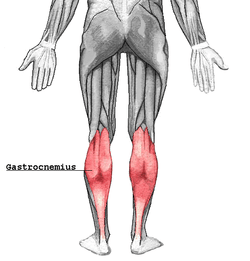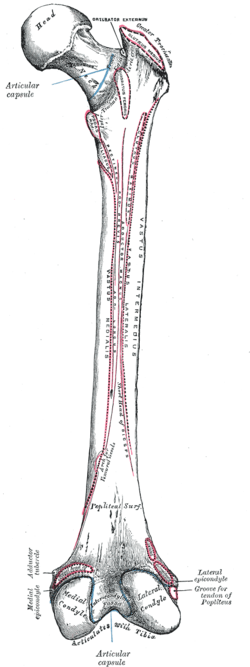Gastrocnemius muscle
| Gastrocnemius muscle | |
|---|---|
 | |
 | |
| Lateral aspect of right leg. | |
| Gray's | p.482 |
| Origin | superior to articular surfaces of lateral condyle of femur and medial condyle of femur |
| Insertion | tendo calcaneus (achilles tendon) into mid-posterior calcaneus |
| Artery | sural arteries |
| Nerve | tibial nerve from the sciatic, specifically, nerve roots S1–S2 |
| Actions | plantar flexes foot, flexes knee |
| Antagonist | Tibialis anterior muscle |
In humans, the gastrocnemius muscle (/ˌɡæstrɒkˈniːmiəs/ or /ˌɡæstrəkˈniːmiəs/; Latin, from Greek γαστήρ "stomach" and κνήμη (knēmē) "leg"; meaning "stomach of leg", referring to the bulging shape of the calf) is a very powerful superficial bipennate muscle that is in the back part of the lower leg. It runs from its two heads just above the knee to the heel, and is involved in standing, walking, running and jumping. Along with the soleus muscle it forms the calf muscle. Its function is plantar flexing the foot at the ankle joint and flexing the leg at the knee joint. In a 1967 EMG study, Herman and Bragin concluded that its most important role was plantar flexing in large contractions and in rapid development of tension.[1]
The gastrocnemius is located with the soleus in the posterior (back) compartment of the leg. The lateral head originates from the lateral condyle of the femur, while the medial head originates from the medial condyle of the femur. Its other end forms a common tendon with the soleus muscle; this tendon is known as the calcaneal tendon or Achilles Tendon and inserts onto the posterior surface of the calcaneus, or heel bone.
Deep to the gastrocnemius (farther from the skin) is the soleus muscle. Some anatomists consider both to be a single muscle, the triceps surae or "calf muscle", since they share a common insertion via the Achilles tendon. The plantaris muscle and a portion of its tendon run between the two muscles, which is involved in "locking" the knee from the standing position. Since the anterior compartment of the leg is lateral to the tibia, the bulge of muscle medial to the tibia on the anterior side is actually the posterior compartment. The soleus is superficial to the mid-shaft of the tibia. Frequently there is a sesamoid bone called the "fabella" in the lateral head of gastrocnemius muscle.
Clinical significance
The gastrocnemius muscle is prone to spasms, which are painful, involuntary, contractions of the muscle that may last several minutes.[2]
A severe ankle dorsiflexion force may result in an injury of the muscle, commonly referred to as a "torn" or "strained" calf muscle, which is acutely painful and disabling.
The gastrocnemius muscle may also become inflamed due to overuse. Anti-inflammatory medications and physical therapy (heat, massage, and stretching) may be useful.
Anatomical abnormalities involving the medial head of gastrocnemius muscle result in popliteal artery entrapment syndrome.
Additional images
-

Right femur. Posterior surface.
-

Cross-section through middle of left leg, viewed from above.
-

Back of left lower extremity.
-

Gastrocnemius muscle
-
Gastrocnemius muscle
-
Gastrocnemius muscle
References
- ↑ Hamilton, Nancy; Luttgens, Kathryn (2001). Kinesiology: Scientific Basis of Human Motion (10th ed.). McGraw-Hill. ISBN 978-0-07-248910-1.
- ↑ "Nighttime Leg Cramps". WebMD. August 19, 2010. Retrieved March 7, 2012.
External links
| ||||||||||||||||||||||||||||||||||||||||||||||||||||||||||||||||||||||||

